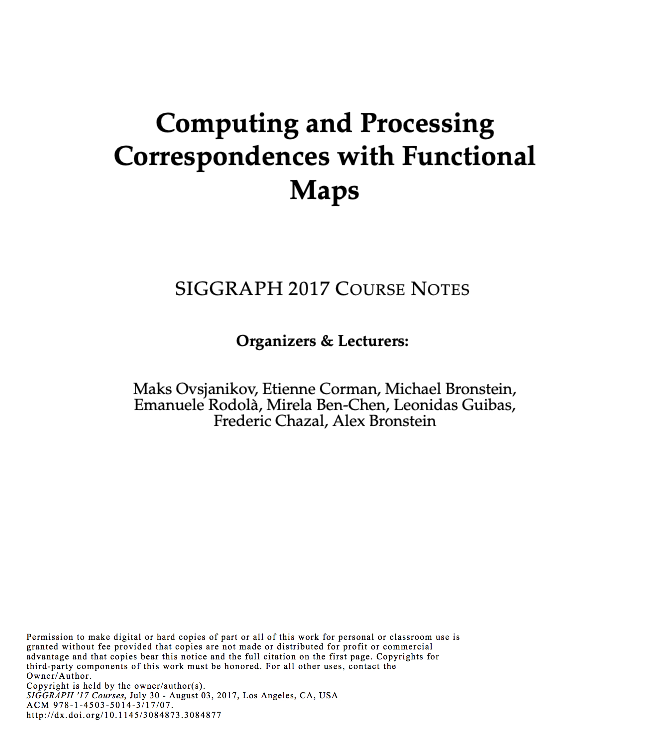Computing and Processing Correspondences with Functional Maps | Maks Ovsjanikov et. al
Computing and processing correspondences with functional maps | ACM SIGGRAPH 2017 Courses
Part I: Functional Maps Basics
P.S. Part name was added by me.
What are Functional Maps?
- Shape correspondence can be represented as the transportation of functions between shapes. If such functions are represented with bases on different shapes, the formulation becomes:
Here the core is :- Noted that here the matrix or can fully encode the shape correspondence, in the form of transportation of basis functions between shapes.
- If only consider the spectral embeddings :
- If is correct, the point-to-point map can be phrased as: , i.e. a correspondence matrix constructed by the dot product between and the transported . Noted that is the spectral embedding of the indicator function of vertex on the shape.
- Inversely , if , which holds for any basis derived from a symmetric matrix operator, e.g. LBO.
- Constraints & regularization
- Function preservation
Such kind the constraint can be constructed with point descriptors, landmark point correspondences, segment correspondences, etc. - Operator commutativity
Apply a linear operator and then transport should be equivalent to first the transport and then apply the linear operator. One example is LBO: , where is diagonal matrix of eigenvalues of LBO on the shape - the matrix form of LBO in the spectral domain.
P.S. For isometry, LBO commutativity should be hold.
- Function preservation
- Conversion to point-to-point maps
It can be proved that is the spectral embedding of the indicator function of vertex on the shape. Therefore, is the transported point indicator functions on to . Finding the nearest s from provides the corresponding points.- Refinement
For volume preserving deformation, should be orthonormal. In this case, aligning and becomes [[BeslPJ1992|ICP]] algorithm and the itself can be iteratively refined.
- Refinement
Part II: Functional Maps in Special Settings
Partial Functional Maps
-
Partial Functional Maps
Assume to be given a full shape and a partial shape that is approximately isometric to some (unknown) sub-region . The authors showed that for each “partial” eigenfunction of there exists a corresponding “full” eigenfunction of for some , such that , and zero otherwise.
Therefore, will shows a slanted-diagonal structure and an angle can pre-computed to optimize for .
-
Deformable clutter
Deals with the case that the shapes only partly overlap, rather than one is the subset of another. In this case, the overlapping parts itself is a variable to be optimized.- Non-rigid puzzles
Maps in Shape Collections
- Descriptor and subspace learning
With a collections of shapes, we can evaluate which point descriptors performance the best and assign best weights to them for matching new shapes. It can even be further used to identify a stable functional subspaces for shape matching. - Networks of Maps
Adding pair-wise links between shapes in the shape collection forms a networks of functional maps. On natural constraint for optimizing the network of maps is cycle consistency, i.e. a cycle of maps show yields an identity map.- Latent spaces
However, optimizing all pair-wise maps is computationally impractical. We therefore turn to construct a latent shape and define as a map from shape to the latent shape. Then .
When all , any cycle of maps will cancel out as . Therefore is a strong constraint to facilitate cycle consistency.
- Latent spaces
- Metrics and Shape Differences
Comparing deformations is a fundamental operation in shape collection. For this purpose we introduce two difference operators acting on functions describing the deformation undergone by the metric ... the area-based and conformal shape difference operators and .
Functional Vector Fields
The idea of functional maps can be transferred to the vector fields domain.
Part III: Advanced Computation & Conversion
Computing Functional Maps
In this chapter, more advanced techniques for solving functional maps are discussed.
- Additional optimization variables
- Joint diagonalization
With near-isometric shapes, should be near-diagonal. However, this doesn't hold for non-isometric shapes. Joint diagonalization optimizes for new basis on that makes diagonal.- Manifold optimization
Classical manifold optimization method includes ADMM.The main idea of manifold optimization is to treat the objective as a function defined on the matrix manifold, and perform descent on the manifold itself rather than in the ambient Euclidean space.
- Manifold optimization
- Unknown input ordering
The ordering of the point descriptor functions could be unstable. The ordering can be considered as a variable during functional map optimization.
- Joint diagonalization
- Coupled functional maps
Simultaneously solving for functional maps from to and from to and imposing the constraint of . - Correspondence by matrix completion
In classical matrix completion problem, one is given a sparse set of observations of a matrix and tries to find the lowest rank matrix with elements equal to the given ones on the subset of indices ... Matrix completion problems are widely used in recommender systems.
Map Conversion
- Optimize the (soft)assignment matrix
In [[#Part I Functional Maps Basics]], we have discussed how to convert functional map to point-to-point correspondence by nearest neighbor search on the spectral embeddings. It can be seen as performing point cloud registration on the embedding space. Here we introduce a (soft)assignment matrix to represent the registration in the optimization framework.- Nearest Neighbors
Equivalent to rigid ICP registration in embedding space. - Orthogonal refinement
Equivalent to orthogonal Procrustes in embedding space. - Regularized Map Recovery
Equivalent to nonrigid CPD registration in embedding space. - Product Manifold Filter for Bijective Map Recovery
The resulting pointwise map can be seen as a “denoised” version of the input, in analogy with classical KDE-based denoising of images.
- Linear Assignment Problem
- Nearest Neighbors
- Continuous Maps via Vector Field Flows
To represent the target point-to-point map as a composition of an arbitrary continuous map between the two surfaces and a flow associated with an unknown vector field on one of them

